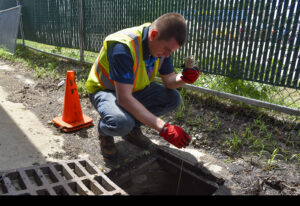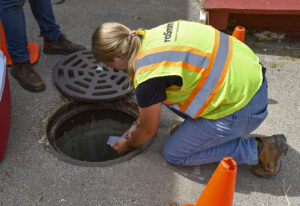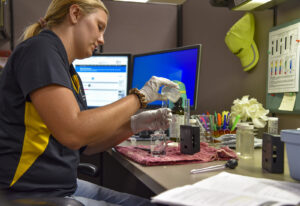News
A robust illicit discharge program that includes collaboration among regulatory agencies, municipalities, businesses and residents can reduce the number of illicit discharges in a community. Here’s how to achieve such a program.

Outfall characteristics may not allow for a grab sample to be easily obtained. To avoid a confined entry, one method is to take a sample from the surface using a string and bottle.
Many factors can negatively impact the health and well-being of our waterways. An important first step to improve our waterways is to monitor the quality of stormwater runoff. A robust illicit discharge program that includes collaboration among regulatory agencies, municipalities, businesses and residents can reduce the number of illicit discharges in a community.
First, it is critical to understand what pollutants plague our waterways and where these sources originate. Examples of polluted stormwater or illicit discharges include runoff leaching out of dumpsters into storm inlets, chemicals dumped by a local business, residential connections between the sanitary sewer and storm sewer systems and others. These scenarios each lead to storm sewer discharges into the waterways that feed our rivers and lakes. Monitoring these discharges helps ensure the health and longevity of our waterways.
Steps to managing illicit discharge

Photographs of the outfall and flow conditions at the time of inspection are important documentation to be saved with each outfall location.
The U.S. Environmental Protection Agency (EPA) as well as state and local regulatory agencies have established requirements for municipalities to implement and enforce programs that help identify and eliminate any illicit discharges of stormwater. The first step in a successful program is to inventory the entire storm sewer system, including inlets, storm sewers, culverts, outfall locations and drainage basin delineations. As-built plans and additional survey information are often needed to fully understand a community’s stormwater system. Once storm sewer outfalls have been identified, they should be classified as a priority, major or minor outfall depending on several characteristics and their illicit discharge potential. Factors such as the history of illicit discharges, aging infrastructure, dense impervious areas, business or industrial park areas with frequent changes in ownership and/or operations, and types of commercial or industrial operations can be used to rank the potential of a possible illicit discharge. Drainage factors of an outfall can change over time and a constant evaluation of a municipality’s outfalls should be considered. After evaluating the potential for illicit discharges, an inspection frequency should be assigned for each outfall. The local regulatory agency can provide specific guidance on inspection frequency.
Routine dry weather inspections at the storm sewer outfalls can aid in identifying the presence of illicit discharges within the stormwater system. If flow is present, samples should be taken from the outfall. Sampling during dry conditions reduces the probability of groundwater and runoff from a rain event contributing to the sample’s contents. If an outfall has a history of low to no flow, the presence of flow during dry weather events can often be correlated to an illicit discharge. If the outfall is dry at the time of inspection, characteristics from an illicit discharge could still be present. The staining of a pipe or dead vegetation are signs that an illicit discharge may have occurred. If an outfall fits this description, future monitoring efforts should be scheduled.
A water sample at an active outfall should be taken during dry weather and analyzed for sensory characteristics such as color, odor and turbidity and indicator parameters such as detergents, pH, total chlorine, copper, phenol, bacteria and ammonia levels. Additional parameters may be tested depending on a municipality’s specific requirements set forth by a regulatory agency or known past illicit discharges. All testing parameters have a recommended action level that is considered out of the normal range. At these action levels, the source of the discharge should be followed upstream to a point where the indicated parameter is no longer detected. At this point, engineering judgment plays a pivotal role in evaluating all observed factors and identifying the exact source of the discharge.
How to identify illicit discharge

Outfall samples can be tested in the field or in the office. If a sample tests positive for a pollutant, staff will need to re-sample the outfall and capture additional samples upstream to determine the location of the discharge.
There are multiple ways to pinpoint an illicit discharge. If a sample tests positive for a pollutant, a parcel-by-parcel investigation should be conducted within the drainage area of the problem outfall. Land use investigations, building permit reviews, as-built construction plan reviews, and property ownership certifications can be useful in locating a potential illicit discharge. If a drainage area investigation does not clearly identify the source, an investigation of the storm sewer network can be performed. Stormwater samples can be taken at each junction point upstream of the outfall to eliminate specific sections of the watershed. If needed, smoke testing, video testing or dye testing may be performed to visually locate the source of the discharge.
Any confirmed illicit discharges should be immediately reported to a local regulatory agency and documented with the municipality to use for future monitoring efforts. In addition, municipalities should create an action plan that identifies who must be notified of the discharge, how the discharge will be eliminated, who will eliminate the discharge, and what response timeframe will be allowed. The property owner should be contacted and if the source is not eliminated in a timely manner, citations and fines may be enforced by the local regulatory agency.
Eliminating every illicit discharge will not immediately fix our degraded waters, but the best practices and collaborative efforts discussed above are critical steps to helping protect the waters that we enjoy year-round.
This article appeared in the September 2023 issue of Stormwater Solutions Magazine (Home | Stormwater Solutions).
About the Authors
 Kate Jankowski
Kate Jankowski
Kate Jankowski is a civil engineer in raSmith’s municipal services division. Kate specializes in private property inflow and infiltration reduction including inspection and flow monitoring activities as well as stormwater inspection and reporting related to MS4 requirements.
 Riley Stone
Riley Stone
Riley Stone is a licensed civil engineer in the municipal services division at raSmith. His primary focus is designing stormwater management and flood control solutions to surface water issues and helping communities meet their respective Municipal Separated Storm Sewer System (MS4) requirements.